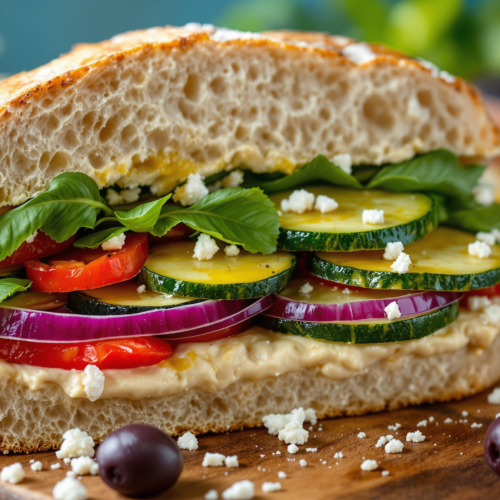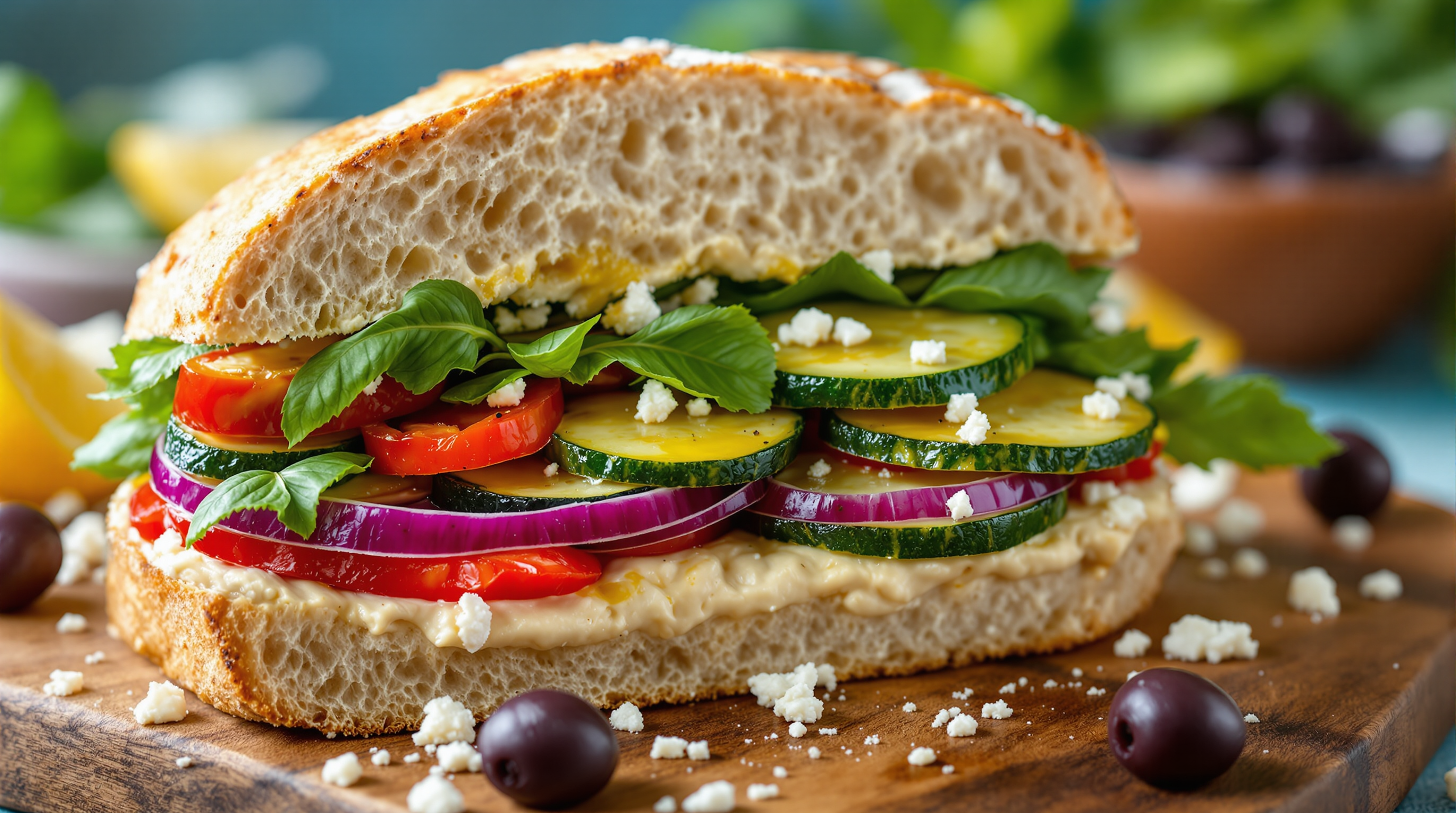In today’s fast-paced world, finding meals that are both nutritious and delicious can be challenging. Enter the Mediterranean veggie sandwich – a vibrant, flavor-packed option that brings the sunny flavors of Mediterranean cuisine right to your lunch table. This isn’t just any sandwich; it’s a carefully crafted combination of fresh vegetables, creamy spreads, and aromatic herbs that creates a truly memorable eating experience.
The Origins of Mediterranean Cuisine
Mediterranean cuisine draws inspiration from the countries surrounding the Mediterranean Sea, including Greece, Italy, Spain, and parts of North Africa and the Middle East. This culinary tradition is characterized by its use of fresh vegetables, olive oil, legumes, and herbs – all components that make their way into the perfect Mediterranean veggie sandwich.
What makes Mediterranean food so beloved worldwide isn’t just its incredible flavors but also its well-documented health benefits. The Mediterranean diet has been associated with reduced risks of heart disease, certain cancers, and cognitive decline. It’s no wonder that incorporating elements of this diet into a simple sandwich has become increasingly popular.
Building the Perfect Mediterranean Veggie Sandwich
The beauty of the Mediterranean veggie sandwich lies in its balance of flavors and textures. Here’s what makes it special:
The Foundation: Bread
Starting with the right bread is crucial. Traditional options include ciabatta, pita, or a rustic sourdough. The bread should be sturdy enough to hold the fillings without getting soggy, yet soft enough to bite through easily. A light toasting adds a pleasant crunch and helps prevent sogginess from juicy vegetables.
The Spread: Hummus and More
No Mediterranean veggie sandwich is complete without a flavorful spread. Hummus, made from chickpeas, tahini, olive oil, and garlic, provides a creamy base that adds protein and holds the vegetables in place. Variations abound, from roasted red pepper hummus to spinach and artichoke hummus. For an extra touch of indulgence, consider adding a layer of tzatziki, a yogurt-cucumber spread, or baba ganoush, a smoky eggplant dip.
The Stars: Fresh and Roasted Vegetables
The vegetables are where this sandwich truly shines. A combination of fresh and roasted vegetables provides contrasting textures and deep flavors:
- Roasted red bell peppers: Sweet, smoky, and tender, these add incredible depth
- Thinly sliced cucumber: Provides refreshing crunch and hydration
- Red onion: Adds a pleasant bite that cuts through creamier elements
- Marinated artichoke hearts: Tangy and tender, these are a Mediterranean staple
- Roasted eggplant: Deeply savory and meaty, perfect for a satisfying sandwich
- Zucchini: Whether raw and thinly sliced or lightly grilled, adds subtle sweetness
The Enhancements: Cheese and Olives
For a touch of salty richness, Mediterranean cheeses like feta or halloumi add an important dimension. Kalamata olives, with their distinctive purple-black color and fruity flavor, bring a briny punch that’s quintessentially Mediterranean.
The Finishing Touches: Herbs and Drizzles
Fresh herbs like basil, mint, or dill add bright, aromatic notes. A drizzle of good quality extra virgin olive oil and perhaps a splash of balsamic glaze adds a final layer of flavor complexity. For heat lovers, a sprinkle of red pepper flakes makes a welcome addition.
Health Benefits Wrapped in Bread
Beyond its incredible taste, the Mediterranean veggie sandwich packs an impressive nutritional punch:
- High in fiber: From the vegetables and whole grain bread
- Rich in plant proteins: Particularly from the hummus and other bean-based spreads
- Loaded with vitamins and antioxidants: From the rainbow of vegetables
- Contains healthy fats: From olive oil, olives, and sometimes avocado
This combination makes the sandwich not just delicious but incredibly satisfying, helping to keep hunger at bay for hours.
Making It Your Own
One of the greatest aspects of the Mediterranean veggie sandwich is its adaptability. Here are some variations to consider:
- Wrap it up: Use a whole wheat tortilla or lavash bread for a portable version
- Go vegan: Skip the cheese or use a plant-based alternative
- Add protein: Include grilled chicken or a hard-boiled egg for an even more substantial meal
- Spice it up: Add harissa or hot peppers for a North African twist
Perfect Pairings
Complete your Mediterranean meal with these complementary sides:
- A simple Greek salad with tomatoes, cucumber, and feta
- Crispy chickpeas seasoned with cumin and paprika
- Tabbouleh, a refreshing parsley and bulgur salad
- A glass of crisp white wine or sparkling water with lemon
Beyond Lunch
The Mediterranean veggie sandwich isn’t just for lunch. Cut into smaller portions, it makes an impressive appetizer for gatherings. The components can also be deconstructed into a sandwich bar, allowing guests to build their own creations – perfect for casual entertaining.
Dietary Considerations
How can I make my Mediterranean veggie sandwich gluten-free?
Use gluten-free bread options such as gluten-free pita, gluten-free ciabatta, or gluten-free wraps. Alternatively, you can create a breadless version using large lettuce leaves as wraps or serve the components as a bowl over quinoa or rice.
How many calories are in a typical Mediterranean veggie sandwich?
A Mediterranean veggie sandwich typically ranges from 350-500 calories, depending on the specific ingredients, portions, and type of bread used. The sandwich is nutrient-dense, providing a good balance of complex carbohydrates, healthy fats, protein, and fiber.
Are there low-carb options for Mediterranean veggie sandwiches?
Yes! Try these low-carb alternatives:
- Use lettuce wraps instead of bread
- Create a Mediterranean veggie bowl with the same ingredients over a bed of greens
- Use hollowed-out cucumber boats or bell pepper halves as vessels for the fillings
- Try low-carb flatbreads or tortillas as the base
How do I boost the protein content in a vegetarian Mediterranean sandwich?
To increase protein without adding meat:
- Use a generous amount of hummus
- Add chickpeas (whole or smashed)
- Include extra feta cheese
- Add hard-boiled eggs
- Incorporate white beans
- Include hemp seeds or sunflower seeds
- Use a high-protein bread variety
Conclusion
The Mediterranean veggie sandwich represents the best of what food can be: nutritious, delicious, customizable, and connected to rich culinary traditions. Whether you’re a committed vegetarian or simply looking to incorporate more plant-based meals into your diet, this sandwich deserves a place in your regular rotation. By bringing together the sunny flavors of the Mediterranean region, it offers not just a meal but a mini culinary vacation you can enjoy any day of the week.
So the next time you’re looking for a lunch option that’s a cut above the ordinary, reach for the ingredients to make a Mediterranean veggie sandwich. Your taste buds – and your body – will thank you.

Mediterranean Veggie Sandwich
Equipment
- Oven or Grill
- Knife
- Cutting Board
Ingredients
Sandwich Base
- 2 ciabatta or pita bread lightly toasted
Spreads
- 4 tbsp hummus classic or flavored
- 2 tbsp tzatziki or baba ganoush optional, for extra flavor
Vegetables
- 1/4 cup roasted red bell peppers sliced
- 1/4 cup cucumber thinly sliced
- 1/4 cup red onion thinly sliced
- 1/4 cup marinated artichoke hearts drained and chopped
- 1/4 cup roasted eggplant or zucchini sliced
Toppings
- 2 tbsp crumbled feta or halloumi optional
- 1 tbsp kalamata olives sliced
- fresh basil or mint for garnish
- extra virgin olive oil for drizzling
Instructions
- Lightly toast the bread if desired and set aside.
- Spread hummus generously on the bottom half of the bread. Add tzatziki or baba ganoush if using.
- Layer roasted red peppers, cucumber, red onion, artichoke hearts, eggplant or zucchini on top of the spread.
- Top with crumbled feta, olives, and fresh herbs. Drizzle with olive oil.
- Close the sandwich, press lightly, slice, and serve immediately.

